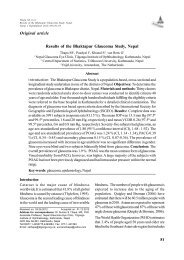nepjoph 2012.pmd - Nepalese Journal of Ophthalmology
nepjoph 2012.pmd - Nepalese Journal of Ophthalmology
nepjoph 2012.pmd - Nepalese Journal of Ophthalmology
Create successful ePaper yourself
Turn your PDF publications into a flip-book with our unique Google optimized e-Paper software.
Panda A et al<br />
Phacoemulsification in eyes with corneal opacity<br />
Nepal J Ophthalmol 2012; 4 (8):217-223<br />
Figure 5: Diagram showing frequency <strong>of</strong> postoperative<br />
complications and management<br />
Figure 6: Pie chart showing postoperative visual<br />
acuity<br />
Discussion<br />
While modern cataract surgery is safe, effective and<br />
provides excellent visual outcome, this outcome may<br />
not necessarily be achieved in eyes with associated<br />
ocular problems or following complicated cataract<br />
surgery. In these cases, there is an increased risk <strong>of</strong><br />
surgical complications and reduced visual outcome<br />
(Salem et al, 1987).<br />
Meredith and Maumenee (1979) classified cataracts<br />
into 3 grades as determined by the surgical outcome.<br />
According to this classification, Salem and Ismail<br />
found 46.5% <strong>of</strong> patients belonged to group II and<br />
III in their study <strong>of</strong> which 41% had co-existent<br />
corneal lesions. Our experience is supported by<br />
their comments, which note a higher incidence <strong>of</strong><br />
coexisting cataract and corneal opacity in developing<br />
countries. Thus, the triple procedure is required to<br />
rehabilitate these patients. Though the triple<br />
procedure (Gong X ,1990; Panda A, 1999; Rao<br />
SK, 1999; Shimmura S, 2003; Baykara M, 2008)<br />
is the method <strong>of</strong> choice to manage corneal lesions<br />
with a coexistent cataract, factors such as scarcity<br />
<strong>of</strong> good donor tissue, post keratoplasty graft<br />
rejection, glaucoma, and infection may impede the<br />
chances <strong>of</strong> successful penetrating keratoplasty<br />
(PK). This may be especially true in patients from<br />
rural areas in developing countries due to irregular<br />
follow up and poor ocular hygiene. Moreover, the<br />
patients with extensive corneal opacity are poor<br />
candidates for PK due to association <strong>of</strong><br />
vascularisation and poor ocular surface as well as a<br />
high chance <strong>of</strong> developing post-operative suture<br />
related problems, which jeopardize the graft status.<br />
Thus, a simple technique is needed. Gupta et al<br />
(1992) and Panda et al (2007) advocate<br />
conventional ECCE to provide ambulatory vision<br />
in such eyes.<br />
In modern era, phacoemulsification is the preferred<br />
technique <strong>of</strong> cataract surgery as it allows for early<br />
visual rehabilitation. However, a successful<br />
phacoemulsification may be difficult in eyes with<br />
corneal opacities because <strong>of</strong> poor visualization <strong>of</strong><br />
intraocular morphology, and altered dynamics<br />
((Farjo AA, 2003; Czumbel N, 2009; Chang YS,<br />
2008). Surgical modifications, such as multiple<br />
sphincterotomy and iris hook application have been<br />
used to enlarge the visible papillary area and to<br />
overcome visual limitations. Use <strong>of</strong> dye, endoscope<br />
and Chandler illumination aided phacoemulsification<br />
also enhances surgical ease (Gregory ME, 2007;<br />
Sinha R, 2004; Uka J, 2005; Bhartiya P, 2002;<br />
Singh D, 1996). In the present study, we desired to<br />
make these patients ambulatory with cataract<br />
surgery alone by modifying the vital steps <strong>of</strong> surgery.<br />
A fully dilated pupil allows visualizing the anterior<br />
capsule and capsular bag anatomy, so efforts are<br />
made to achieve this by breaking the posterior<br />
synechiae with additional sphincterotomies. This<br />
technique not only increases the visibility, but also<br />
helps improve post-operative visual outcome. The<br />
quality <strong>of</strong> peripheral vision may be expected to be<br />
sub-optimal when compared to central vision.<br />
However, Drew’s and Drew’s (1964) advocated<br />
optical iridectomy in eyes with obscured pupillary<br />
221




